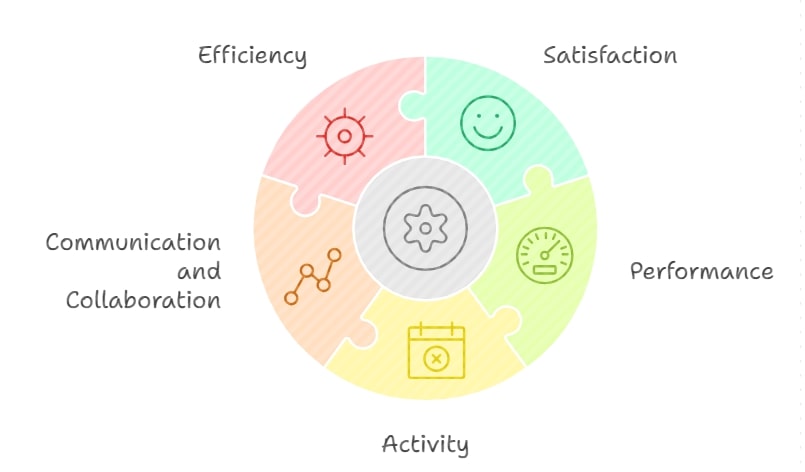In a competitive tech landscape, software development can feel like a race against time. Teams must juggle rapid feature delivery, code quality, and developer engagement. Pushing too hard risks burnout or accumulating technical debt. Engineering efficiency offers a balanced approach that maintains speed, quality, and team well-being.
What is engineering efficiency?
Engineering efficiency is the art of maximizing outcomes, high-quality releases, and positive user experiences while minimizing waste, confusion, and busy work. Unlike a single-minded focus on velocity, efficiency emphasizes smarter workflows, balanced workloads, and technical excellence.
Key benefits of efficiency in software engineering include:
- Faster time to market: When approvals, handoffs, and testing are streamlined, features and fixes reach production sooner. This responsiveness can be a major competitive advantage.
- Reduced technical debt: Sprinting to release without thinking long-term often leads to bloated, fragile code. Efficiency keeps the codebase tidy, reducing future firefights.
- Healthier teams: Excessive pressure and poorly organized workflows drain morale. By refining processes and cutting down on pointless overhead, engineers can focus on meaningful, creative work.
- Better resource utilization: Every hour spent waiting for feedback is time lost. Engineering efficiency helps organizations direct talents and budgets where they generate real value.
Engineering efficiency metrics
Measuring engineering efficiency is a tricky task. You need to avoid vanity metrics like lines of code and lean on insights that show how effectively and sustainably you deliver features.
- DORA metrics: Developed by the DevOps Research and Assessment (DORA) team, this gauges how frequently you deploy, how quickly you fix issues, and how often changes cause production failures. They offer a window into delivery speed and overall reliability.
- Cycle time: This is how long it takes for a piece of work to go from “in progress” to “done.” Shorter cycle times reflect better collaboration and fewer bottlenecks.
- Defect rate and MTTR: Tracking how many bugs surface and how quickly they’re fixed indicates code quality and responsiveness to customer needs. A spike in either metric can signal a lapse in process or code discipline.
- Flow efficiency: Compare the time engineers spend actively coding or testing versus waiting on approvals or environment setups. If waiting dominates, it might be time to streamline reviews or improve tooling.
- SPACE framework: Looking at satisfaction, performance, activity, communication, collaboration, and efficiency provides a more holistic measure, mixing quantitative data with developer well-being and collaboration dynamics.

How to increase engineering efficiency
Once you’ve identified relevant metrics, the next step is embedding them into daily workflows. Below are core strategies for boosting software engineering efficiency:
1. Automate repetitive work
- Tasks like testing, code coverage checks, and deployments eat up engineering time if done manually.
- Continuous integration/continuous deployment (CI/CD) pipelines can offload these tasks.
- By automating routine chores, you allow engineers to concentrate on real problem-solving, whether that involves architectural improvements or new feature design.
2. Embrace Agile and DevOps
- Agile methodologies like Scrum or Kanban promote iterative cycles and frequent feedback, aligning well with DevOps principles of smooth handoffs from development to operations.
- This synergy breaks down silos, shortens feedback loops, and helps teams release valuable features sooner.
3. Encourage a collaborative culture
- It’s hard to overstate the value of open dialogue. Daily standups expose blockers early, code reviews foster shared knowledge, and regular retrospectives encourage constant adjustment.
- Encouraging pair programming or mentorship can further spread expertise, preventing any single developer from becoming a bottleneck.
4. Developer productivity engineering
- Instead of focusing solely on features, consider the developer experience: how long are build times? Are there frequent integration conflicts?
- By systematically gathering data on these pain points, teams can refine tooling and processes, leading to smoother development cycles.
5. Refine your ecosystem
- Too many specialized tools or poorly integrated systems slow down teams.
- Ensure your project management software, code repositories, and QA tools connect seamlessly.
- Centralizing notifications and feedback in one place lets developers quickly see what needs attention and why.
6. Balance creativity with accountability
- While pressure can drive short-term results, excessive speed can lead to sloppy code and an exodus of talented developers.
- Conversely, letting engineers perfect every line of code can stifle timely releases.
- Strive for a healthy tension: set achievable deadlines and accept that not every idea needs to be polished to 100% before shipping.
Common pitfalls and how to overcome them
Engineering efficiency can unravel if you’re not aware of these typical stumbling blocks:
- Resistance to change: Changing your build pipeline or adopting new collaboration tools can stir skepticism. Mitigate this by involving engineers early, offering training, and celebrating incremental wins that demonstrate value.
- Misaligned priorities: Executives might push for rapid releases while engineers fight for code quality. Regular, transparent alignment meetings that involve leadership, product managers, and engineering can prevent conflicts and keep everyone working toward the same outcome.
- Blind faith in metrics: Quality data is crucial, but it can also lead to gaming the system. Keep an eye on unintended behaviors; if a certain metric is overemphasized, people might tweak their workflows in ways that look good on paper but harm team health.
- Ignoring team well-being: The push for higher efficiency can tempt managers to demand constant sprints or overtime. Yet overworked engineers lose creativity, and burnout leads to churn. True efficiency factors in rest, breaks, and flexible schedules.
Conclusion
Engineering efficiency means achieving more with fewer resources while maintaining high code quality and keeping teams motivated. By choosing the right metrics, such as cycle time, defect rate, or DORA, organizations can identify bottlenecks and refine their pipelines. Still, data alone isn’t enough: genuine progress requires strong collaboration, well-chosen tools, and a people-centric culture.
As the industry evolves, engineering or code efficiency is about working smarter, not harder. By refining processes, metrics, and culture, organizations can stay adaptable to shifting technologies and user demands without exhausting their teams.
